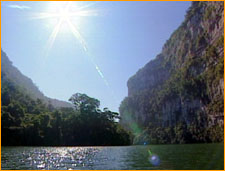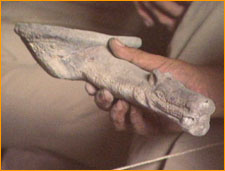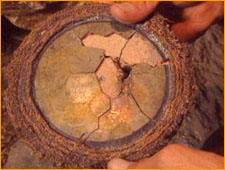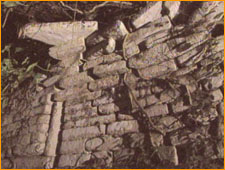|
|
|
|
 |
 |
Archaeologist Thomas Lee In 1997, Thomas Lee joined an expedition of archaeologists and spelunkers to the Chiapas region of Mexico. There, in a series of caves hundreds of feet above the Rio La Venta, the expedition members found the remains of a people called the Zoque who once inhabited the region. Some 20 miles from the caves, the archaeologists also stumbled across a large ceremonial site, which they named El Tigre. In the following interview, Lee recounts the highlights of that expedition, and his hopes for future work in the region.NOVA: Why are the Zoque important?
NOVA: How did you first come to know about the caves along Rio La Venta? TL: What happened was that some hunters in the 1940s acquired cloth and some other archaeological materials from a cave and gave those to Tulane University. Tulane published that and I was able to locate the guide who had taken those hunters into the canyon and he took me back to that cave in the late '60s. And so I excavated in that cave. And that's what we call Media Luna. Media Luna was really the first modern archaeological excavation in that area.
TL: Well, Sahagun describes this for the 16th century among the Nahuatl, the Aztec. He said the priests went out and went towards the market and looked for women who were selling their children—their babes in arms. And so I think it's probably pretty logical that, if you had slave children, you would use them first. If you didn't have anybody else, maybe you'd have to sacrifice one of your own children. It sounds pretty—boy, it couldn't be much more terrible. But it's gone on again and again all over the world. NOVA: Is the work that you carried out early in 1997 the beginning of a larger project? TL: Yeah, a long project, we plan on carrying out there. The canyon offers dry caves, which present the possibility of recovering materials that we can't find anywhere else—cloth, cords, vegetable remains, and whole burials with clothing still on them, and that sort of thing. We knew the people were living
NOVA: Tell us more about the textiles you found. TL: Well, you know, I saw them against the light for just a few minutes. I haven't seen them since. I suppose some day I will. But since they're delicate, they were supposed to go off to Mexico and be conserved. And then come back, and then we could study and photograph them. I don't even have photographs of them. The Zoques had cloth with up to 70 to 80 threads per inch. And that was all, of course, spun by hand and woven by hand. The designs we've seen so far were not embroidered. They were actually worked into the weaving, which is a much more difficult process. NOVA: You found incense burners in some of the caves; what was burned in them? TL: Well, incense. But also cloths that were used to catch the blood of the auto sacrifice—from the nose or the fingers or the genitals or the ears—the blood is caught in this special cloth and is burnt. Food was also burnt as part of the offering. And even parts of the body were burnt, like the heart and other things were special offerings to the gods. NOVA: As a way of providing nourishment to the gods? TL: Yes.
TL: Well, the mirrors were for devination; the shamans used them. But they were also a great status symbol, because they were very difficult to make. And as you may recall, in the history of the conquest, Montezuma supposedly foresaw the coming of Cortez by looking in his mirror. So he had one. And in some of the principle burials at the sites we've excavated, we find the highest individual often has a mirror. Sometimes the mirrors are oxidized and what we really wind up with is the back part. So that mirror in that cave is really special because we've never seen a mirror in the country - in these open sites - that had some kind of fabric woven to it. NOVA: Tell us about the expedition itself. TL: You know, it's really merciless country to work in—too hot and rugged for a 63-year-old man. But I had the time of my life, I'll tell you. I'd do it again. Because you know, things are exciting. I've worked a lot of Zoque archaeology, but I never worked a building with the wall standing and a doorway you could walk into and covered with beautiful decoration. NOVA: You're referring to the large "El Tigre" site that you found on the expedition—what kind of shape was it in? TL: It's basal platform was filled in with rubble, and—it's a real snake pit, I'll tell you. It's just got a leaf mulch on top and then all these little caves are just filled with snakes.
TL: Literally with snakes. Yeah, it's no fun. It's a bad area in that sense. You know, the two guys who took us down in there said, "We're not going to sleep here because we're afraid of the tigers." So we built a big fire and didn't hear even one that night. But I got to talking to one of these guys and he said, "You know, it's funny, we're all afraid of the tiger, but there are more people that die from snake bite than tigers. We haven't lost anybody from a tiger here, but we've lost three or four people from snake bites." Tigers are fierce but they're not that lethal. NOVA: Did you find that the structures at El Tigre had astronomical alignment? TL: Yeah, I can't prove it because we didn't have the time, but they obviously did—all the sites are laid out astronomically. NOVA: What are some of the celestial markers that were used? TL: Well, we won't know until we've actually worked it out. Because it changes in different places. This would have to be done by an expert, in order to really come up with specifics in terms of one celestial body or another. You have to have really precise measurements. I wouldn't, at this point, dare say, "It's aligned with Venus." NOVA: Could you tell how large a population lived at El Tigre?
NOVA: So, in thinking about your return trips, is your greatest hope still to find a book? TL: Yeah. NOVA: It's a dream? TL: Yeah, that's what draws me on. I'd rather find one page of a book than a chest of gold, you know. I'd settle for a half a page. That's why I went into the cave in the '60s, because I thought, if there's any place where there's a book, it's going to be down in one of these dry caves where people haven't gotten into it. For one thing, it's an isolated area, and the other thing is that the preservation is such that the book could have resisted the centuries. But, you know, I'll probably never find it. 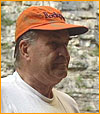 Thomas A. Lee is professor at the University of Sciences
and Arts of the State of Chiapas. He took his Master's
degree in 1966 in anthropology at the University of Arizona,
Tucson, and has spent 35 years working as an archaeologist
in southern Mexico. Lee has published over 100 scientific
books and articles, and was recently awarded the Premio
Chiapas in Science by the Chiapas State Government in
recognition of his service in writing the ancient history of
the area.
Thomas A. Lee is professor at the University of Sciences
and Arts of the State of Chiapas. He took his Master's
degree in 1966 in anthropology at the University of Arizona,
Tucson, and has spent 35 years working as an archaeologist
in southern Mexico. Lee has published over 100 scientific
books and articles, and was recently awarded the Premio
Chiapas in Science by the Chiapas State Government in
recognition of his service in writing the ancient history of
the area.Before and After | Future Ruins | Thomas Lee | Be an Archaeologist Teacher's Guide | Resources | Transcript | Cave People Home Editor's Picks | Previous Sites | Join Us/E-mail | TV/Web Schedule About NOVA | Teachers | Site Map | Shop | Jobs | Search | To print PBS Online | NOVA Online | WGBH © | Updated November 2000 |
||||||||||||||
